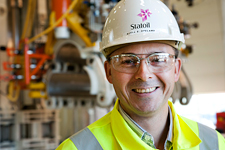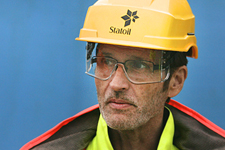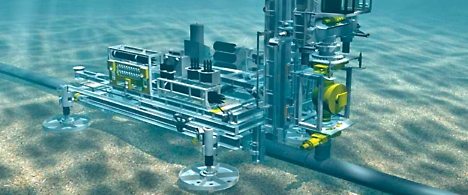These types of operations can save Statoil lots of money in the long run.
The hot tap installation is the first to be carried out in connection with preparations for Åsgard subsea gas compression in the Norwegian Sea, and thus also represents a milestone for the project. The tie-in point was welded on to the Åsgard B production flowline at a water depth of 265 metres.
After ten days on the field, the hot-tap operation team on board the Technip-owned vessel Scandi Arctic could confirm success in the pioneering operation.

Kjell Edvard Apeland, project manager of the remote-controlled hot tap development in Statoil and head of the operation on the Åsgard field. (Photo: Rune Solheim)
"For a subsea engineer, this can be compared with landing on Mars," says Kjell Edvard Apeland. He is project manager of the remote-controlled hot tap development in Statoil and head of the operation on the Åsgard field.
Simply explained, a remote-controlled hot tap operation consists of a robot welding a T-piece on to the pipe, while gas is flowing through it. When that has been done, a remote-controlled drilling machine will drill holes in the producing pipeline, with no effect on pressure and production.
"When the compressor module and the manifold for Åsgard subsea compression are installed next year, we will connect the pipeline from these to the hot-tap tie-in point," says Apeland.
The Åsgard subsea compression project will be realised in 2015, as the first of its kind in the world. Compressors will be installed on the seabed, instead of on a platform. This will improve recovery from the Mikkel and Midgard reservoirs by around 280 million barrels of oil equivalents.
Major savings
Hot tap technology is a technological breakthrough, and a door opener for developing marginal fields, as well as extending the lifetime of other fields.
The ability to connect anywhere on a pipeline, without stopping production, yields considerable flexibility and significant savings.

Torstein Vinterstø, portfolio manager for subsea compression projects in Statoil. (Photo: Anette Westgård)
"Since we will be connecting a new compressor station on the seabed to an existing pipeline system on Åsgard, it is very beneficial to use the hot tap technology to avoid disrupting production," says Torstein Vinterstø, portfolio manager for subsea compression projects in Statoil.
"The savings are measured compared with what it would have cost to perform a similar operation, including shutting down production in the pipeline we were working on. This would also have taken much longer than the ten days we spent now - possibly as long as three months," he says.
Home-grown technology
The method was developed by Statoil, and there is no comparable technology.
The work to develop the technology started in 1999, and was developed in Statoil's pipe technology environment at Killingøy outside Haugesund. Statoil's expertise in tie-in and repair of pipelines is gathered there.
Open and constructive cooperation with our key suppliers has been instrumental in achieving this.
Statoil has already thoroughly tested the hot tap technology, with good results. Remote-controlled hot tap has previously been performed on Tampen Link on the Statfjord field in the North Sea and on the Ormen Lange field in the Norwegian Sea, but then the T-piece had already been installed on the gas pipeline in advance.

Illustration: Åsgard subsea gas compression.